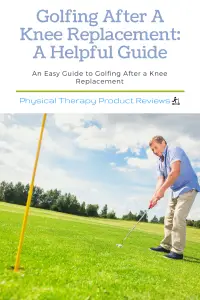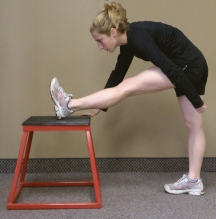After a total knee replacement, you’ll likely be able to move your knee with far less pain, navigate stairs without trouble, and stand up from a chair with ease. But, the real question is, can you return to golf??
Can I Golf after a Knee Replacement?
 The short and sweet answer: Yes! Research shows us that when people return to golfing after a knee replacement, they usually do so with less pain, a handicap improvement, and increased weekly playtime.
The short and sweet answer: Yes! Research shows us that when people return to golfing after a knee replacement, they usually do so with less pain, a handicap improvement, and increased weekly playtime.
The goal of a total knee replacement is to decrease your pain and improve your daily function. That also translates to the golf course and you’ll be happy to know that returning to golf is typically expected and very successful!
How Long After a Knee Replacement Until I Can Golf?
You will likely be able to return to golfing within 6 months after your surgery. Most golfers are able to complete a full 18 hole course before 4 months! Until then, there is plenty to work on to improve your game before you even step onto the grass.
After a total knee replacement, your knee needs to be strengthened and conditioned to safely return to golfing. The mechanics of the golf swing place rotational pressure on the knees and this takes time to work up to after surgery.
Tips for Returning to Golf After a Knee Replacement
To cart or to walk?
The vast majority of total knee replacement patients return to playing golf and most of them also return to using a golf cart. Your surgeon may advise this for you too, especially when you first return to the sport.
If you plan to eventually walk the course, use your rehabilitation time to improve the endurance of your knee with the guidance of your Physical Therapist.
Shoes:
Opt for golf shoes without spikes. Even if your old spike shoes are lucky, let’s be honest, they’re due for a replacement too. Shoes with spikes give your foot an extra “grip” on the turf, and this can cause extraneous torque at the knee joint. You’ll be protecting your knee and extending your golfing habit by going spike-less.
Knee Braces:
You can certainly wear a knee sleeve or protection brace while playing golf. Consult with your surgeon or Physical Therapist for specific recommendations.
The Golf Swing:
Start off your training with a half swing and work your way up to a full swing. You can consult with your Physical Therapist or golf trainer to guide you through using a step-through swing. Especially if your knee replacement was completed on your front leg, further decreasing rotational stress will be beneficial.
Stay active in other ways, too!
It’s best to have a variety of activities to stay in shape. Try using some other low-impact exercises to keep your knee strong and healthy. Think, cycling, swimming, and strength training.
Stretches for Golfers with a Total Knee Replacement
Before you head onto the course (and after you finish your game), try these stretches to keep your knee limber and ready.
Hamstring stretch:
Seated on the edge of a chair, extend your leg out in front of you with the heel in contact with the ground. Point your toes towards the ceiling and begin to bend forward from your hips, keeping your back straight. Once you feel a stretch behind your leg, hold for 30-45 seconds. Repeat 3x.

Quad stretch:
Stand next to your golf cart, facing outward. Hold on to the cart for balance assistance. Bend your knee to raise your foot behind you and find a position to rest in on the cart where you can also feel a stretch along your front thigh. You may need to use your hand or a strap to assist your foot up behind you. Hold for 30-45 seconds, repeat 3x.
Calf stretch:
Place your hands on the golf cart seat and step your leg backward into a lunge position. Keeping your knee straight and encouraging your heel closer to the ground, you should feel a stretch behind your knee and down your calf. Hold 30-45 seconds and repeat 3x.
Rotational stretch:
Plant your foot upon the platform of your golf cart and hold on for balance assistance with your hand. Keeping your foot in place, gently drop your knee to the outside to open up your hip. Hold for a few seconds, then drop your knee to the inside to rotate your hip inward and hold for a few seconds. Continue on in this manner for 1-2 minutes.
What to Avoid when Golfing after a Knee Replacement
As covered above, there are a few things to avoid when returning to golf after a total knee replacement.
- Avoid spiked shoes and attempting to walk the course before you’re ready.
- Avoid revving up your swing right off the bat. You’ll need to start with small partial swings to prep your knee for a motion that feels old to you but will be new to your knee.
Avoid trying to rush your rehab! Take it slow and steady. Just like golf, you’re in this for the long game.
Is Golfing After a Knee Replacement Bad
Not at all! Golf is a low-impact sport and most surgeons highly recommend it as a form of light exercise. Don’t attempt anything before you’re ready for it and your game will be golden.
Conclusion
You can certainly return to golf after a total knee replacement and do so with less pain and more function! Take your rehabilitation slow and steady and you’ll see that hard work pays off on the course.
Written By:
Lisa Woolridge, DPT
After graduating from the University of Texas Health Science Center at San Antonio, Lisa served as a physical therapist in the Army. She treated orthopedic injuries in soldiers and family members, ran fitness testing clinics, and conducted wellness classes. Lisa left the military when she became a mother and remains involved in the medical field through freelance science writing and consulting.
Works Referenced:
Hurley-Booker E, Great golf after hip or knee replacement. Golf Fitness Magazine. 2009.
Jackson JD, Smith J, Shah JP, Wisniewski SJ, Dahm DL. Golf after total knee arthroplasty: do patients return to walking the course? The American Journal of Sports Medicine. 2009.
Pinger C, Belitty JP, Simon R, Rouillon O, Smith BJ, Nizard R. A playtime and handicap analysis of 143 regular golfers after total knee arthroplasty at minimum 2 years follow up. The Journal of Arthroplasty. 2020; 35(5).
How to Stay Active After Cervical Fractures: Expert Tips and Advice
Dealing with Painful Stairs After Ankle Replacement Surgery
Walking After a Total Ankle Replacement: Tips for a Successful Recovery
Exercises While Non-Weight Bearing After Ankle Replacement: Elevation, AROM, Leg Raises, and More
Ankle Pain with Stairs: Causes and Home Treatment Options
5 Common Mistakes You’re Making After an Ankle Sprain
Disclaimer: The information provided in this post is for educational purposes only. This is not a substitute for a medical appointment. Please refer to your physician before starting any exercise program.






